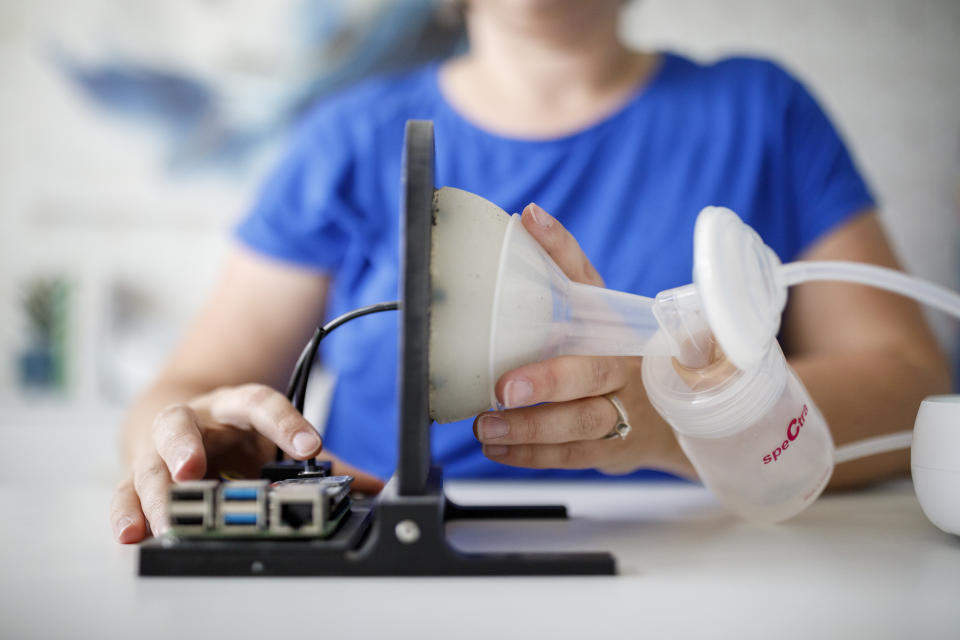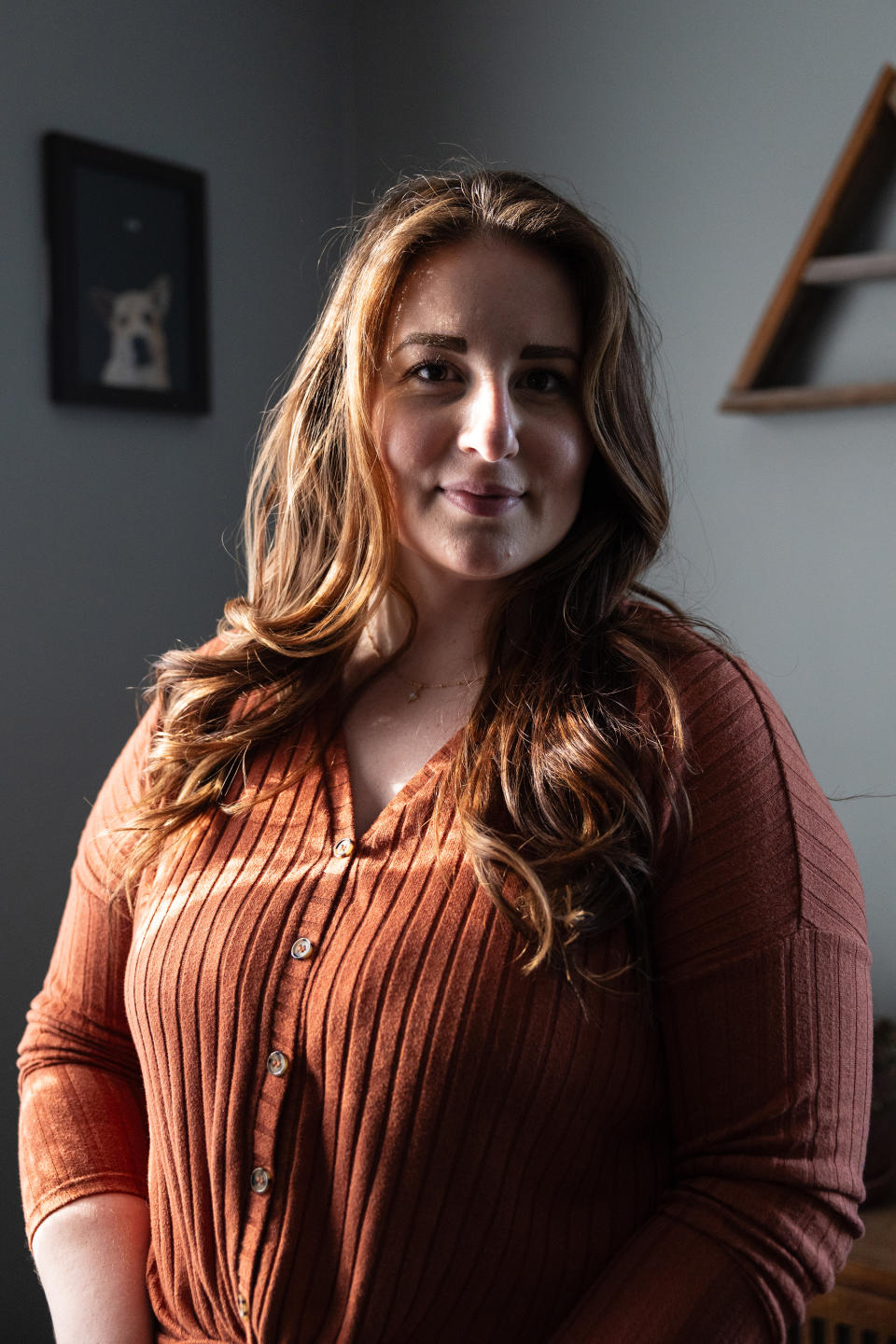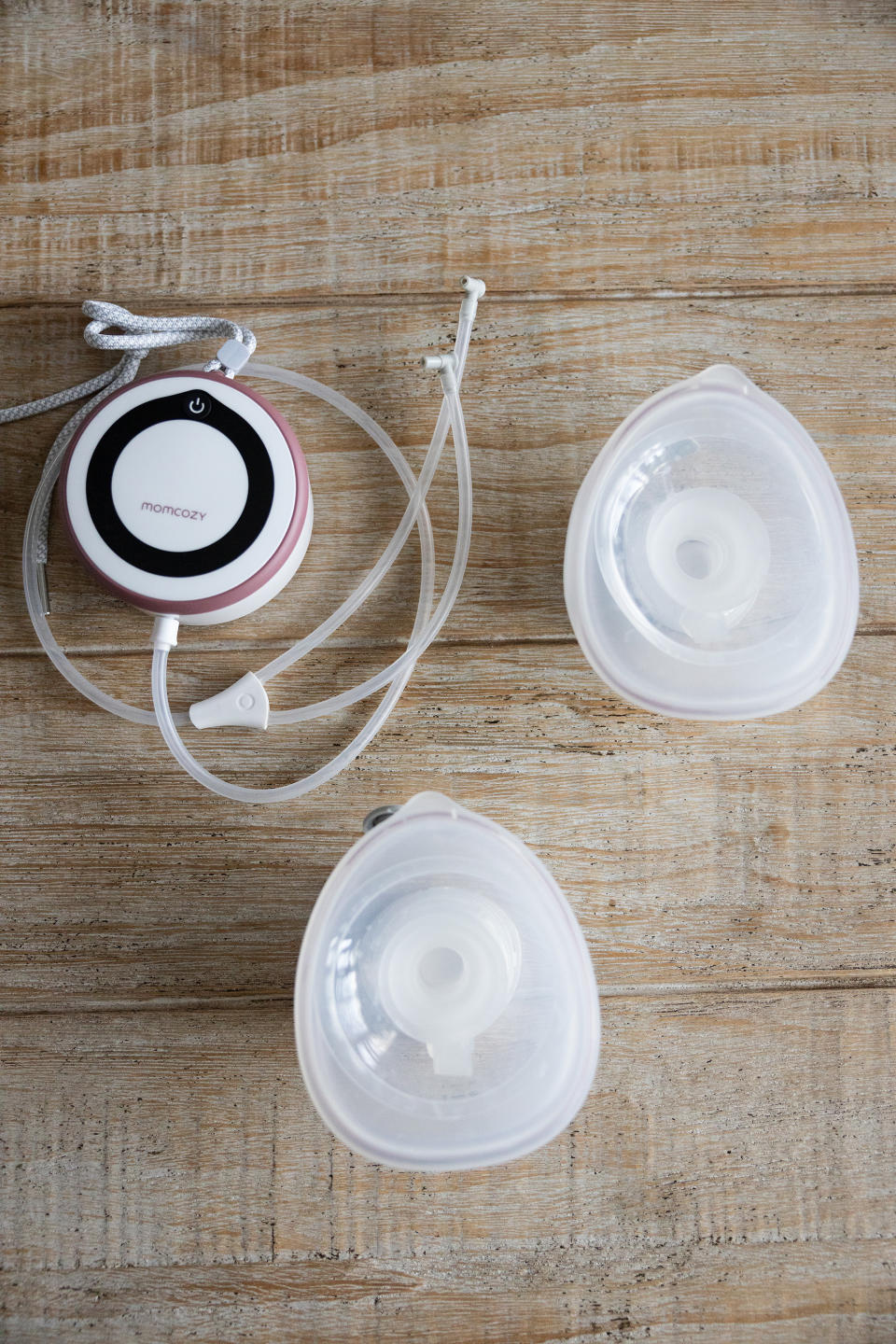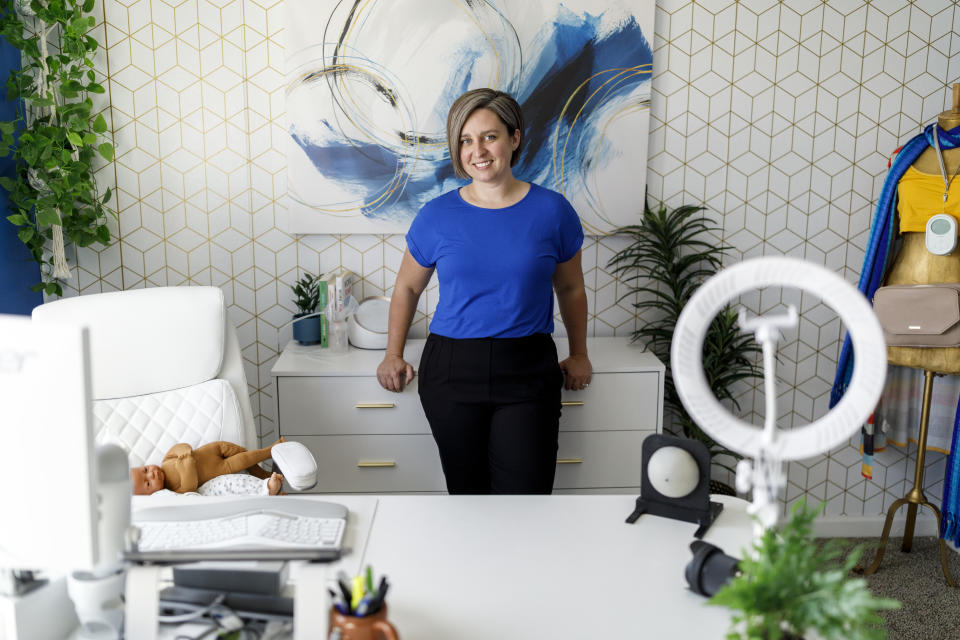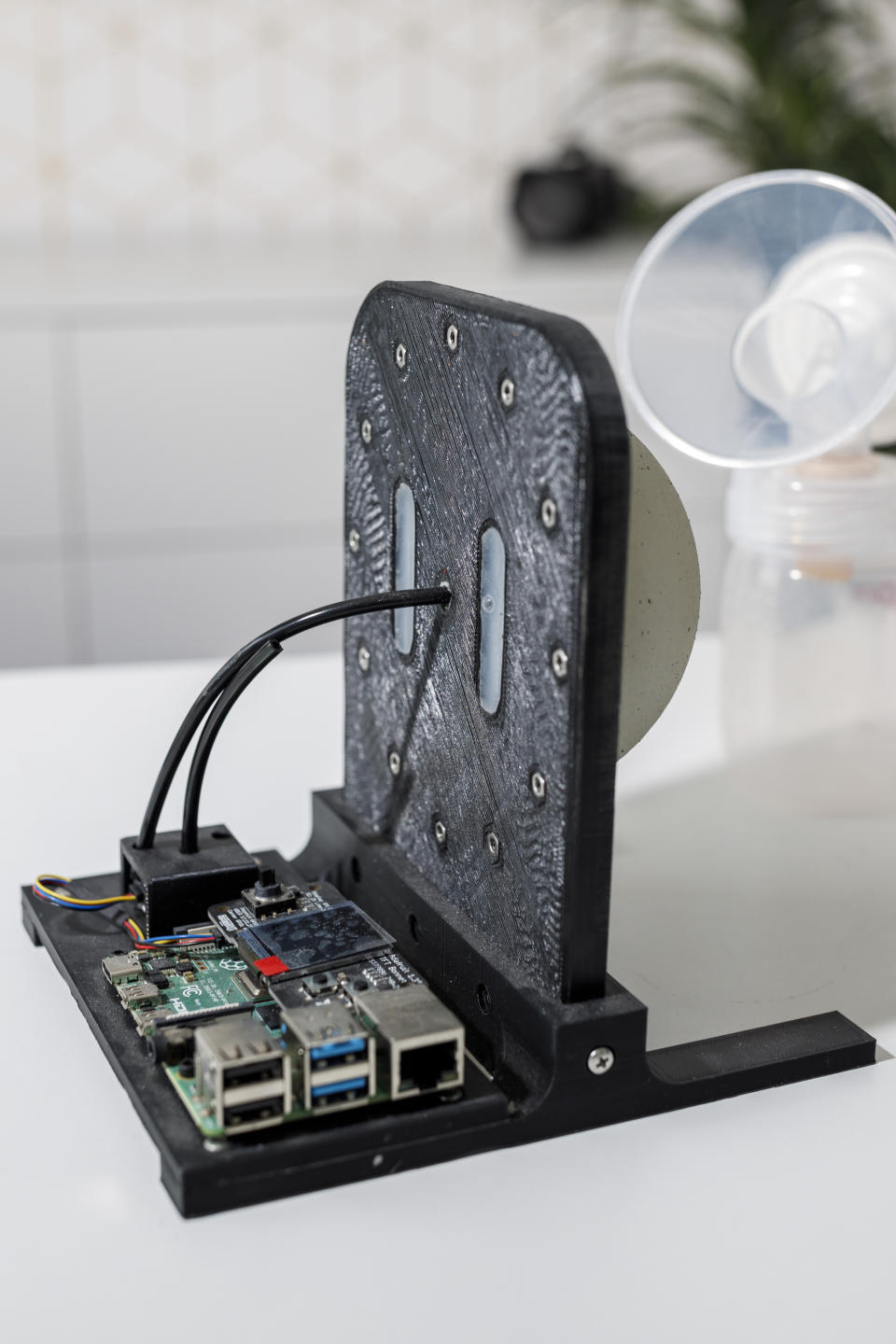Using a breast pump at work used to require privacy. Not anymore.
- - -
Correction: An earlier version of this article misspelled the name of an Israeli breast pump manufacturer. The company is Annabella, not Anabella. The article has been corrected.
- - -
Laura Curtis sits in a Maine courtroom, her breast pump whirring quietly beneath her blouse.
The 39-year-old lawyer is recently back at work after giving birth to her second child. “It’s very convenient, which I think is what most women want,” Curtis said of her hands-free electric breast pump, which she tucks inside her bra and controls with her smartphone. Curtis wears it often - to church, to the grocery store, and in the car. “It’s super discreet.”
When Curtis had her first child seven years ago, she used a comparatively clunky, plug-in pump she chose from a few available options. Now pumps are so diverse that many women feel overwhelmed. Curtis made a spreadsheet to compare the many models on the market, a few of which she decided to purchase and test out. She has since shared the spreadsheet with other women.
The global breast pump market - estimated at $2.94 billion in 2023 - is projected to reach $5.2 billion by 2030, according to a new report by market forecaster Grand View Research. Lactation experts say the industry’s growth is due to various factors, including technological advancements, improved legislation and support for mothers - such as the Affordable Care Act (ACA) and the recently passed Pump Act - as well as cultural shifts.
“The market is crazy,” said Allison Tolman, a nurse and lactation consultant who helps working mothers with breast pumping. “New innovation can be a good thing, but it can also be a problematic thing.”
- - -
Pumps of the past
For decades after the first electric breast pump was invented in the 1940s, they were widely considered painful, cumbersome, heavy and noisy. Women primarily used them to improve milk supply, relieve engorged breasts and feed babies too frail to nurse.
The Swiss medical company Medela, one of the veteran breast pump manufacturers, released its first electric portable breast pump in 1991, later refining it in 1996 to appeal to active and working mothers. While Medela’s pumps have been available in the United States for about 45 years, the company experienced a significant boost in demand after the ACA was signed into law in 2010, requiring insurance providers to cover the cost of breast pumps.
“The ACA was a turning point,” said Annette Brüls, the global chief executive of Medela.
Since then, breast pump brands have been increasingly focused on offering mothers a long-sought sense of freedom.
“For every circumstance and for every need, we want to make sure we have the right pump,” said Brüls.
- - -
Pumps are progressing
By the early 2000s, some 85 percent of breastfeeding American women had used a breast pump - and experts say that number has probably grown considerably in recent years as pumps have become more accessible and user-friendly.
“Now, you don’t have to be tied to your baby 24/7,” said Tolman, who worked with an engineer to design a breast pump testing device she calls the “Boobie Barometer.” She regularly reviews breast pumps on YouTube and has created a popular support group on Facebook specifically for working moms.
For Lauren Trevino-Hurst, 31, a surgical nurse in Troy, Ohio, the ability to pump on the job is paramount. As a mother of three - ages 10, 3, and 1 month - Trevino-Hurst, like Curtis, has seen the industry evolve with each of her pumping experiences.
“It’s not like it was 10 years ago,” she said, adding that when she was pumping with her first baby in 2013, wearable options hadn’t yet hit the market. She used a stationary plug-in pump by Ameda. Shortly after Trevino-Hurst had her second baby, in 2020, she wore a wearable pump while working in the operating room. The device collected milk inside a bra insert rather than an exterior container.
“There would be times I would be scrubbed in for five or six hours and I’d be wearing my pump,” she said. “I liked the ability to be on the go.”
Many women feel likewise - hence the push for more-portable pumps.
- - -
Recent innovations
Willow Innovations brought its wearable breast pump to market in 2018, and sales were upward of $10 million in the first year.
Sarah O’Leary, chief executive at Willow, says the pumps are popular with both working moms and stay-at-home moms who have their hands full. With the Willow 3.0 Pump, “you can pump in any position without spillage,” O’Leary said. “Mom can bend all the way over. She can even do a cartwheel.”
While traditional plug-in pumps tend to cost $150 to $300, top-tier wearables are usually about $500. As a result, “people are making them cheaper and easier and redesigning them,” said Tolman. “It used to be that there were $500 wearables or nothing.”
Although many inexpensive pumps are poorly made and ineffective, the “you get what you pay for” principle doesn’t always apply. For instance, the Bellababy wearable pump retails for about $50.
“It worked so well for me,” said Amara Salloum, 33, who lives in Toronto with her husband and their 11-month-old son. Salloum had been dreading the idea of being connected to a machine with tubes and a plug-in base. She didn’t want to feel like a cow being milked.
Many modern breast pumps integrate smart technology, allowing users to monitor milk expression in real time, track pumping sessions and easily adjust their settings using a smartphone app. Some pumps have memory modes that allow moms to record a pump session and use the same settings later. Moms can often personalize their pump by adjusting suction patterns and strength levels, as well as massage modes and cycle speeds. These features are part of the marketplace for intuitive breast pumps.
Some manufacturers are designing products intended to mimic a baby’s natural sucking pattern. Annabella, an Israeli company co-founded by a woman, recently released the first breast pump to simulate a baby’s tongue. In a clinical trial, the unique pump extracted almost twice as much milk on average as the most popular pumps on the market.
Likewise, a few manufacturers are reimagining flanges, the funnel-shaped plastic or silicone pieces that fit directly over the nipple. A relatively new pump by Babyation - a company founded by a husband-wife duo in St. Louis - uses a unique suction technology that allows the flanges to latch to the breast in a way that imitates a baby’s mouth.
- - -
Pumping is personal
Although breast pump innovations show promise, ultimately, pumping is personal. There is no one-size-fits-all pump, no matter how modern they get.
“Pumping is not just ‘put on a breast pump and push play,’” explained Tolman. “Pumping is an art. There are a lot of factors that go into making it work effectively.”
A pump that works seamlessly for one mother might not work well for another. Lauren Cunningham, for example, has so far bought five breast pumps - three wearables and two others. Generally, used breast pumps are nonrefundable.
“You have to try a few to find the right one,” said Cunningham, 35, who gave birth to her first child in early October and went back to work in January at a commodities company in Stamford, Conn. “It becomes very, very expensive.”
Cunningham is an exclusive pumper and does not breastfeed. “I just liked knowing what I was feeding her,” she said, “and that I was giving her enough.”
While wearables have been relatively easy to use, Cunningham said, she has found them to be less powerful than other electric pumps. That’s a common problem.
Tayla Hecht, 29, has had similar struggles. With a wearable pump, “I felt like I wasn’t getting any milk out,” said Hecht, who lives in New York City with her husband and their 4-month-old daughter. She watched dozens of reviews on YouTube and reached out to more-experienced pumpers for information.
She, too, tried several pumps, none of which she was completely satisfied with. In the end, after having difficulties with breastfeeding, Hecht now feeds her daughter formula.
Hecht’s experience is not unique. After decades of stagnancy, the breast pump industry is now overpopulated with options, and lactation experts say it can be hard for some mothers to cut through the clutter.
“There’s way too much information out there, and moms don’t know how to navigate it,” said Katie Clark, a Colorado-based lactation consultant and blogger. “There’s a lot of bad marketing. I’d love to see more standards.”
- - -
Looking ahead
While breast pump brands have made strides technologically, women are seeking straightforward information about the mechanical power of each pump, how it performs, who it would work best for and what features it’s equipped with.
“There’s so much more that you could get right or wrong now, depending on what kind of machine you have,” said Curtis. “I’d like to see more transparency; that would really make breast pumps better.”
Breast pump brands say they’re listening to moms as they continue to advance. “The way that Elvie innovates is by talking to women about health issues that are troubling to them, and really rethinking those issues and disrupting the women’s health landscape,” said Kerry Bailey, the U.S. general manager of Elvie, a major player in the wearable pump market. “We listen to our customers really closely.”
Curtis used the Elvie Stride.
Women remain hopeful about the future of breast pumps. “The technology has advanced, and I hope it will continue to get better and better,” said Curtis. “I’ve got two girls and I want their pumping experience to be peachy if they decide to have kids.”
Related Content
After voting to legalize weed, Marylanders are mixed on impact, poll finds
Shadowing Trump’s attacks on mental fitness — his own father’s dementia
In Wisconsin, a vote for Biden or Trump could come down to grocery prices
